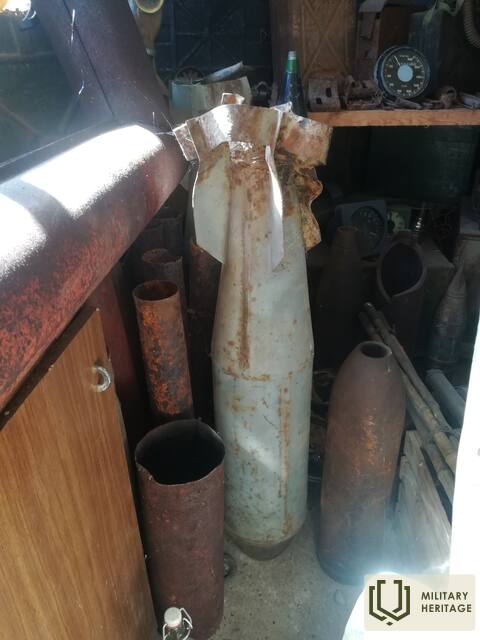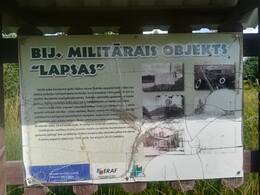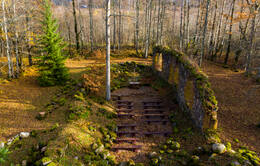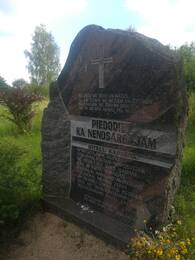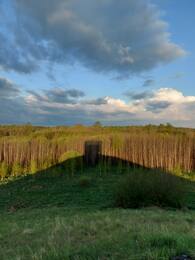Zvārdenieka's childhood in the shadow of bomb explosions - Phosphorus capsules
Ich verbrachte meine Kindheit in der Nähe des Zvārde-Schießstandes, unter den Geräuschen von Explosionen und fliegenden Düsenflugzeugen, aber manchmal konnte ich am Wochenende den Schießstand betreten. Nach dem Abzug der sowjetischen Armee war das Land mit Bombentrichtern und vielen explosiven Gegenständen übersät, nicht nur aus der Zeit der Deponie, sondern auch aus dem 2. Weltkrieg. Besonders die Jungs haben gerne Phosphorkapseln verbrannt ...
Jagd nach Phosphorkapseln
Zwei Jahre lang gingen wir im Sommer auf die Mülldeponie, um nach Phosphorkapseln zu suchen. Phosphorbomben wurden in unmittelbarer Nähe der simulierten Landebahnen gefunden, da ihre Funktion darin bestand, den Bombenangriffsbereich während der Nachtbombenangriffe zu beleuchten. Während des Beschusses ließen sich die Phosphorbombenkapseln mit kleinen Fallschirmen über dem Ziel abwerfen und erhellten den mehrere Kilometer entfernten Himmel. Wir haben die unverbrannten Phosphorkapseln aus den Bomben genommen und sie in Mittsommerfeuern verwendet, weil sie mit einem extrem hellen Licht brannten ...
Susijusi laiko juosta
Susijusios temos
Susijusios vietos
Zvārde shooting range and former Soviet military base "Lapsas"
The landfill's service base is located approximately 2 kilometres east of Striķu Manor, on the Saldus-Auce road. The former Soviet Military Aviation Target Range (military unit No 15439) in Zvārde is located south of Saldus. The territory of the airfield is home to several sights - the ruins of Zvārde and Ķerkliņi churches, the ruined Rīteļi cemetery, the observation post of the airfield, the so-called "Officers' Kurgan" and the former airfield personnel base and shooting range "Lapsas".
The Zvārde air target range required a unit of approximately one company to service the air target range - to install targets, repair damage, guard the air target range and coordinate air flights. It was based on the site of the house called "Lapsas" until the Second World War. With the construction of the airfield, barracks, transport sheds, a flight control tower and a firing range for training personnel were built.
After Latvia regained its independence, the Zvārde Defence Forces Training Centre operated here, but since 2007 the site has been owned by the municipality and leased by several hunting collectives. The former barracks house an exhibition on the history of Zvārde parish.
Zvārde church ruins
The ruins of Zvārde Church are located on the territory of the former Zvārde air target range, near the so-called "Kurgan of the Officers". After a kilometre and a half, you will pass a T-junction with the Rīteļi cemetery nearby.
The first wooden church and rectory were built here in 1567, and the stone church was built in 1783 at the expense of local peasants, Kurzeme nobles and Duke of Courland Peter Byron. During the Second World War, the church roof and tower were damaged in the fighting. In 1953, when the Soviet Ministry of Defence requested the establishment of an air-target range on the site, Zvārde Church, Ķerkliņi Church and Rīteļi Cemetery were placed in the centre of the air-target range - next to an artificial airfield with access roads and defensive positions, which was used as a target by Soviet pilots. Planes flew here from airfields in Latvia and elsewhere in the Soviet Union. In less than 40 years, the church, the cemetery, the former manor house and dozens of surrounding buildings were reduced to ruins.
Riteli Cemetery
After the airfield was established in this area in 1953 at the request of the USSR Ministry of Defence, the Zvārde Church, the Ķerkliņi Church and the Rīteļi Cemetery were actually located in the centre of the airfield - next to an artificial airfield with access roads and defence positions, which was used as a target by Soviet pilots. Planes flew here from airfields in Latvia and elsewhere in the Soviet Union. In less than 40 years, the church, the cemetery, the former manor house and dozens of surrounding buildings were reduced to ruins. Today, the site is cared for by the Saldus Martin Luther Church. The surrounding area is still contaminated with unexploded ordnance and it can be dangerous to walk off the roads.
Barbarism reached its peak in 1988, when the Rīteļi cemetery with its graves and monuments was bulldozed.
On 21 July 1990, in one of the first actions in which the Latvian population demanded that the USSR army leave the territory of Zvārde, a protest rally was held in Saldus, after which people went to the Rīteļi cemetery. The rally participants were allowed into the landfill site, and they cleaned up the cemetery a bit and dug white crosses.
The landfill continued to be used until 1992 and even as late as March 1992 a plane taking off from Lielvārde crashed in the landfill for unknown reasons. The Latvian Defence Forces started demining the site in May 1993, after the withdrawal of the Russian army. In 2008, Zvārde residents installed a memorial stone "Forgive us for not saving you" in the Rīteļi cemetery.
Soviet air force target firing ground in Zvārde
Zvārde landfill is located in Zvārde municipality, Saldus region. It is a former military aviation training ground of the USSR, covering more than 24 000 hectares.
The territory of the former airfield is home to several sites: the Officers' Kurgan, the ruins of the Zvārde and Ķērkliņi churches, the Rīteļi cemetery, the former army base "Lapsas", and others. Until the Second World War, the site of the observation tower was home to the "Vairogi" house. During the construction of the polygon, what was left of the farm - walls, the remains of the apple orchard, and part of the ruins of the Veczvārde manor - was piled together to form a mound and the observation tower was built on it. It was used as an observation point for coordinating the army's training manoeuvres. This place is popularly known as Kurgan. The mound overlooks the former training ground and the wooded areas of Zvārde Nature Park and Nature Reserve. A good place for bird watching. The surroundings of Kurgāns are not landscaped.




